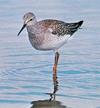- yellowlegs
-
/yel"oh legz'/, n. (used with a sing. v.)either of two American shorebirds having yellow legs, Tringa melanoleuca (greater yellowlegs) or T. flavipes (lesser yellowlegs).[1765-75, Amer.; YELLOW + LEGS]
* * *
They have trim, gray-brown and white streaked bodies; long bills; and long, bright yellow legs. Both species breed in Canada and winter in South America and eat small fish and other aquatic creatures. The lesser yellowlegs (T. flavipes), about 10 in. (25 cm) long, appears in sizable flocks on mudflats during migration; it has a flat call of one or two notes. Less common is the greater yellowlegs (T. melanoleuca), which is about 14 in. (35 cm) long and has a longer, stouter, slightly upturned bill; its call is a clear three-note whistle. Lesser yellowlegs (Tringa flavipes)Mary M. TremaineRoot Resources
Lesser yellowlegs (Tringa flavipes)Mary M. TremaineRoot Resources* * *
▪ birdeither of two species of American shorebirds with trim, gray-brown and white streaked bodies, long bills, and long, bright yellow legs. They belong to the genus Tringa of the family Scolopacidae; this family also includes the curlews, turnstones, sandpipers, and snipes.The lesser yellowlegs (T. flavipes), about 25 cm (10 inches) long, appears in sizable flocks on mud flats during migration between its breeding grounds across Canada and Alaska and its wintering ground from the Gulf of Mexico to southern Chile and Argentina. The greater yellowlegs (T. melanoleuca), about 35 cm (14 inches) long, with a proportionately longer and stouter (and slightly upturned) bill, has similar breeding and wintering ranges but is everywhere less common and more wary than the lesser yellowlegs. Individuals of the two species may be nearly the same size but are easily distinguished by voice: usually the greater yellowlegs gives a clear three-note whistle; the lesser, a flat, light call of one or two notes. Both species feed on small fish and other aquatic creatures (e.g., insects, crabs, snails, and tadpoles).During the autumn migration, the lesser yellowlegs, and sometimes the greater, occasionally stray to western Europe, where they might be confused with other Tringa species, such as the greenshank, the redshank, and the wood sandpiper.* * *
Universalium. 2010.
